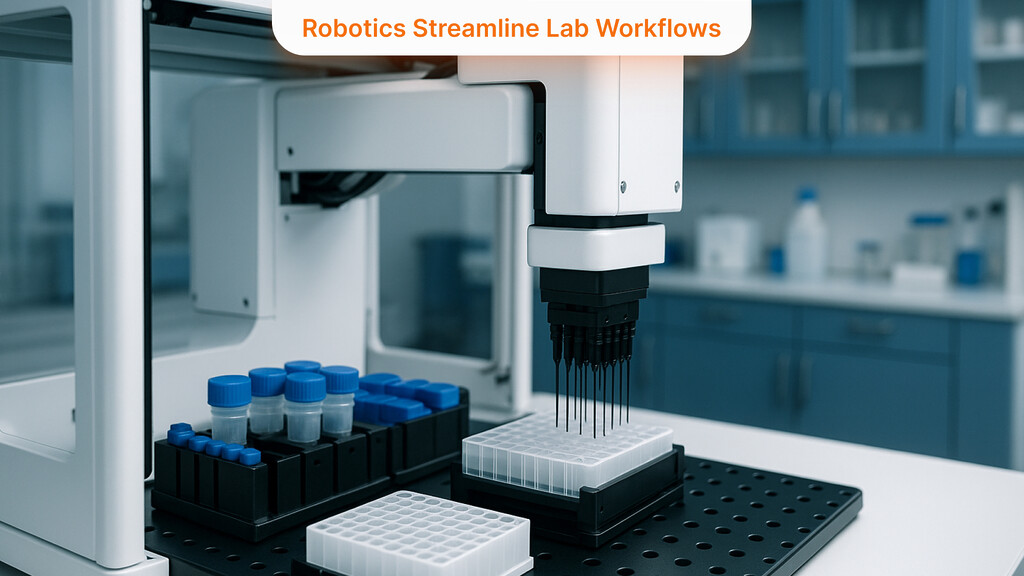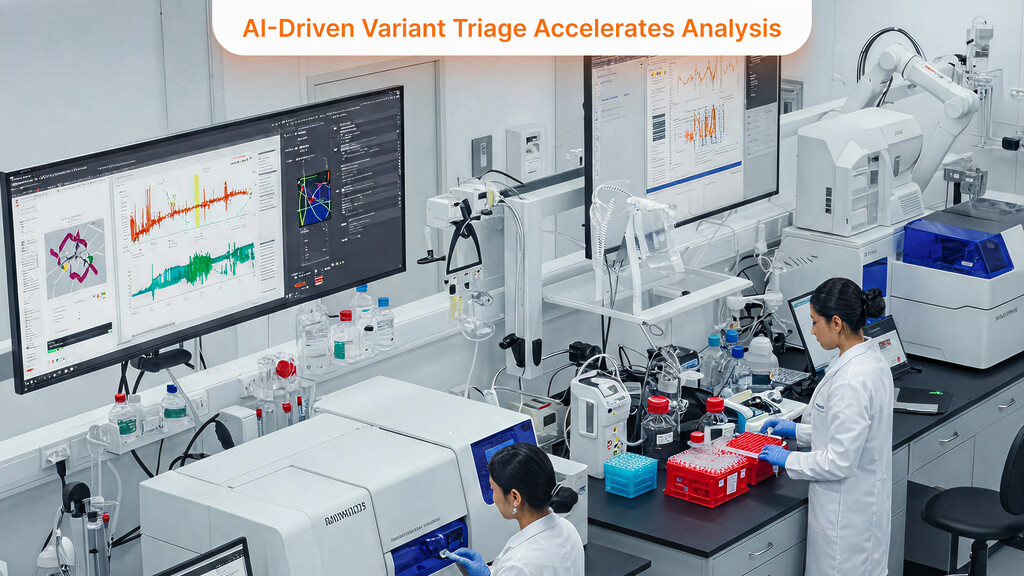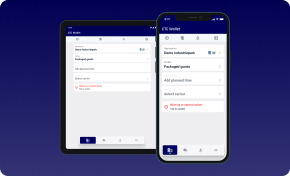Today’s genetic testing laboratories operate under the highest level of pressure ever experienced. Labs must perform higher volumes of tests at reduced capacity because both staff deficits and growing testing needs persist. The 2024 survey revealed that understaffing emerged as the top challenge for laboratory professionals, with 39% of respondents selecting it as their main pressing issue. Meanwhile, several laboratories needed to shut down briefly because of employee shortages. Genetic testing labs boost their output quality by adopting automation and more innovative workflow systems. The research indicates that automation needs expansion to meet rising test demand because 89% of testing facilities require additional automation, yet 91% anticipate AI-driven solutions will assist them. The genetic testing laboratory industry has decided to combine robotics with informatics and artificial intelligence processes to handle growing workload requirements. The outcome delivers multiple benefits, including quicker testing periods, lower error rates, and staff relief, providing essential market advantages.
Robotics Streamline Lab Workflows

Robotic automation stands as a primary innovation sector within the wet laboratory environment. The latest generation of liquid-handling robots performs time-consuming research work such as DNA/RNA extraction combined with PCR setup and library preparation for sequencing applications. Automation decreases manual pipetting work and human errors and boosts the number of tests performed per hour. The combination of Pacific Biosciences with automation partners enabled them to develop robotic library preparation protocols that process 96 sample libraries automatically with minimal human intervention. The robotic workflows developed by PacBio enable laboratories to reach sequencing levels of thousands of genomes a year because these systems yield consistent outcomes while reducing expenses and boosting sequencing speed, according to their Chief Commercial Officer.
Custom Software Development for a Competitive Edge
Build Unique Software Solutions with Our Expertise
Explore Custom SoftwareRobotics systems now perform time-consuming operations, including plate preparation alongside reagent distribution. A robot performs assay plate setup tasks for all 96 wells simultaneously, which would require multiple hours of work from a technician in addition to introducing unnecessary variations. Genetic testing labs commonly use bench-top DNA extraction robots as one of their standard equipment. Such devices implement programmed protocols to bind DNA samples and automatically wash. The combination leads to standardized yield outputs while giving laboratory personnel genuine unattended work periods. A new automated cfDNA extractor proved that its automated processes lead to actual unattended operation time, reduce contamination risks, and enhance testing precision while improving efficiency. Robot automation of repetitive pipetting tasks enables laboratories to extend their operating hours night and day, substantially increasing test processing capacity without straining their staff.
Digital Tracking and LIMS Integration: Eliminating Errors
Data management is a core aspect of automation systems beyond robot implementation. Modern genetic laboratories have started using barcode systems and integrated informatics solutions to make their workflows more efficient. Barcoded sample handling is a standard procedure to maximize efficiency and minimize errors. Upon laboratory sample entry, each item receives a distinctive barcode that staff members scan during all processing stages instead of traditionally noting down identification codes. Adopting barcode systems ensures substantial benefits because research concludes that these systems reduce sample identification errors between 50–97%. Modern automated tracking technology produces results that exceed what traditional Sharpie usage on tubes ever could achieve.
Modern laboratories enhance their barcoding systems by directly integrating LIMS (Laboratory Information Management Systems). Data transfer within the system occurs automatically because instruments and software establish direct connections that feed results into the database. Through instrument-LIMS integration, automatic data capture processes replace manual entry steps, which reduces human errors during data transcription. PCR machine Ct values and sequencing run completion are immediately recorded in LIMS systems using barcode identification. A single unified data source for sample information becomes available through this smooth connectivity system, which ensures complete data load.
Web Development for a Strong Digital Foundation
Build a Robust Online Platform with Our Expertise
Discover Web DevelopmentAn expert in laboratory informatics characterized the combination of deep LIMS integration with barcoding as a system that removes nearly all human errors, leading to more accurate operations and regulatory compliance. The result includes fewer sample misidentifications, immediate reporting without delays, and full traceability of all results. Digital sample workflow management enables laboratories to process more samples with reduced mistakes, which becomes especially beneficial during staffing shortages.
Unlocking Business Efficiency with Intelligent Document Processing (IDP) on AWS provides a compelling case for leveraging AI to automate documentation workflows, which is critical for labs burdened by paperwork.
AI-Driven Variant Triage Accelerates Analysis

The automation techniques reach beyond laboratory workstations into the analysis part. The recent emergence of AI-driven workflows serves as a strong tool to expedite genetic test result interpretation while dealing with testing bottlenecks. Single genomic tests like whole-exome or genome sequencing produce hundreds of genetic variants, which healthcare investigators must evaluate to identify those with medical significance. Before AI intervention, geneticists or pathologists needed many weeks to manually analyze these results, which involved extensive manual work by traditional geneticists or pathologists. Specialists now benefit from an initial variant triage system that runs through artificial intelligence algorithms, which saves them vast amounts of time.
The current algorithms used in AI analysis swiftly process variant information while simultaneously comparing databases to detect pathogenic mutations. The process, which used to require weeks, can now finish in a matter of minutes. The training of a million genetic variants with AI systems enabled their identification in minutes instead of waiting weeks to improve rare disease diagnosis. Machines trained through machine learning technology produce ordered lists of potential disease-causing variants for individual cases. An analyst would need to look at only the top 5–10 candidates selected by AI instead of reviewing all 100 variants. Recent testing demonstrated that an AI system successfully identified about 95% of known pathogenic variants and eliminated extraneous data, which enables scalable testing expansion without increasing labor requirements for laboratory experts.
The application of AI technology executes straightforward variant interpretation tasks, which permits medical genetics specialists to dedicate their skills to challenging or unclear analysis. The systematic review through vast data resources provides consistent analysis for every sample, thus decreasing potential human mistakes. The medical field sees many labs currently testing AI-based tools for variant annotation system integration into their informatics workflow. This process allows laboratories to provide shorter wait times before informing physicians and their patients. Lab healthcare has a crucial need for rapid responses, making this speed boost an absolute industry game-changer. Research studies show that laboratory management teams understand AI’s value because more than 90% of them recognize AI tools can resolve current testing challenges in patient testing services. Genetic testing laboratories that adopt AI for data analysis establish it as a fundamental competitive advantage for businesses that seek future development.
AI Integration for Transformative Results
Amplify Your Business Potential with Our AI Expertise
Access AI Integration SolutionsNavigating FDA Compliance for AI-Powered Healthcare Tools and EHRs offers vital insights for labs seeking to implement AI responsibly and follow U.S. regulatory requirements.
Speed and Efficiency as a Competitive Edge
Genetic testing operations need faster turnaround time (TAT) to function as a competitive advantage. Medical organizations, physicians, and research clients prefer laboratory partners that deliver fast yet precise results. Automating workflows enables laboratories to reduce assay TAT significantly, leading to better client satisfaction rates and higher throughput numbers. Automated processes work continuously without human delay and eliminate waiting periods for operator input. The DNA test process, which takes two weeks and involves fewer employees, will be finished within a few days. The high-throughput lab achieved TAT improvements on 65% of its samples through integrated automation, resulting in better turnaround times than its competitive lab counterparts. Automating laboratories enables them to generate results faster while processing more cases, thus drawing in additional business opportunities.
The speed increases generated through automation lead to additional testing output. Shortening the result generation time allows your laboratory to serve more patients using existing equipment and personnel. Laboratory TAT reduction enables doubling the facility’s output without adding additional equipment, which results in higher operational productivity and profit. The accelerated testing process allows labs to handle additional tests while avoiding hardware and manpower expansion. The laboratory benefits from enhanced scalability because the demand for genetic testing continues to increase annually.
Implementing automated quality improvements by laboratories leads to an enhanced reputation through their quality performance. Reducing human contact in sample handling leads to better accuracy because it eliminates mistakes and lab errors. Labs that successfully achieve quick turnarounds for testing and high analytical performance become superior competitors to their market rivals. A robust automation system allows labs to create better partnerships by providing reliable and quick data to their research sponsors and clinical partners. The lab with faster test result delivery times of 24 to 48 hours will distinguish itself from other labs with similar test menus in such competitive environments. Workflow investment creates more than operational advantages since it delivers marketing benefits to the organization. The combination of speed, efficiency, and accurate results creates improved service quality, generating business expansion.
The Business Case: ROI, Scalability, and Talent Utilization

Biotech executives and lab directors must base their decisions on automation through business performance measures. Implementing robotics alongside workflow software in laboratory operations demands initial capital spending, although this investment leads to considerable return on investment (ROI). Automated systems enable labs to conduct more tests through their employees, thereby avoiding unnecessary hires and expense growth. The system generates higher revenue potential by maintaining control over labor expenses. According to one analysis, the initial implementation cost exceeds the first-year budget, yet “the long-term savings and ROI are substantial” because labs achieve higher productivity rates while cutting down on errors. A lab can achieve greater revenue growth alongside higher volume operations by using automation systems beyond manual operations. End-to-end automation enables laboratories to increase their annual sample processing capacity by thousands when using a small team because the technology handles most of the operational volume.
Scalability
Regular use of automation systems decreases the need for costly corrections and reprocessing work. Automatic systems reduce human mistakes by a remarkable margin (according to one study, automation eliminates 70% of errors, thus minimizing reagent consumption and test repetition time). The reduced error rate shields businesses from potential expenses that could stem from incorrect results, which can cause legal and reputation-related financial losses. Better quality and consistency enhance the lab’s financial stability.
Talent Utilization
When their tasks are automated, staff members can develop their potential. Your organization can maximize the potential of specialized staff members through task automation because you transfer time-consuming routine work to machines. Laboratory staff with medical science expertise can shift their focus from manual tasks such as pipetting and data entry to advanced analysis, assay development, and client service enhancement. Automation enables the distribution of additional free time to staff members who can dedicate themselves to healthcare improvement activities.
A lab director mentioned that automation made it possible to move junior lab assistants into simple tasks while relocating medical laboratory scientists to essential testing and analysis procedures. The effective deployment of expert employees while enhancing their job satisfaction occurs because experts want to perform meaningful work instead of repetitive tasks. The present shortage of laboratory scientists makes it essential to deploy existing expert staff optimally. Removing repetitive tasks through automation helps decrease staff burnout, resulting in minimized employee turnover. All business justifications for automation stem from improved productivity, reduced mistakes, and enhanced workforce utilization. The automation investment yields financial return through increased lab efficiency and expanded capacity over multiple years.
Cloud-based infrastructures play a pivotal role in achieving this. The HyperSense article Leveraging AWS for Scalable Genomics Data Storage and Processing explores how genetic testing labs can manage massive genomic datasets with cost-effective and scalable solutions.
Partnering for Smarter Labs
Genetic testing laboratories need to innovate their processes to maintain leadership positions. Your lab should implement automation and workflow optimization because these innovations create sustainable development and superior service delivery within an industry that is becoming more competitive. Laboratories can deliver quick results at high standards despite workforce limitations by implementing robotics, digital tracking, and AI analytics. The organizations that think ahead now leverage technology to maximize productivity through their existing staff members.
IT Consultancy for Strategic Advantage
Tailored IT Solutions to Drive Your Business Forward
Discover IT ConsultingLabs seeking modernization need to select appropriate technologies in combination with specialized expertise. HyperSense Software is ready to assist you in your business transformation journey. We provide specialized services to biotech and diagnostic labs, where we implement robotic systems and LIMS interfaces and deploy AI-driven data workflows based on their specific needs. The system should create an efficient operation that enables your scientists and technicians to deliver maximum value.
Combining automation and innovative software platforms is the fundamental driver of laboratory productivity. Properly implementing these technologies will enable your laboratory to enhance its operational capacity and decrease mistakes while allowing your staff to boost their performance and speed up test reporting to customers and patients. Such a solution creates advantages for both laboratory functions and overall business achievements. You can build a better future for your genetic testing operations by connecting with technology providers at HyperSense who bring extensive experience to genetic testing solutions.
The collaborative design process with our team will help your lab maintain its leadership position in the fast-moving genetic testing industry.
What are the main causes of staffing shortages in genetic testing labs?
The problem of understaffing in genetic testing laboratories is severe due to the increasing number of tests, staff burnout, and a shortage of competent laboratory professionals. The recent survey revealed that 39% of lab workers identified understaffing as the most significant challenge. This scarcity would cause bottlenecks that would protract testing and reporting and lower overall productivity. As the market moves towards individualized medicine and genetic diagnostics, labs need to scale to meet these demands, and the most sustainable approach is automation to maintain turnaround times and service quality regardless of workforce constraints.
How can automation help genetic testing labs manage limited staff and high workloads?
Automation helps laboratories handle repetitive, time-consuming tasks without requiring human personnel. The automated systems assist with sample preparation, reagent handling, and data entry, freeing lab technicians to focus on high-value activities such as assay development and data analysis. It results in wasted time, fewer manual errors, and a smoother workflow. The automation tools used by labs enable around-the-clock operation, enhancing throughput and quality even when few people are working. The outcome is a stronger organization that can do more, even with current staffing limitations.
Which lab processes can be automated in genetic testing?
Nearly every stage of a genetic testing workflow can be automated. Common applications include:
- Sample and reagent handling (robotic arms or liquid handlers),
- DNA/RNA extraction and purification,
- PCR setup and sequencing preparation,
- Barcode labeling and tracking, and
- Data entry into LIMS or reporting software.
With these workflows automated, variability will be reduced, precision improved, and reproducibility ensured. The trend in many modern labs has been toward end-to-end automation, with human intervention confined to supervision and exception management, thereby enhancing both throughput and reliability.
How much can automation increase the throughput of genetic testing labs?
A lab’s testing capacity can be expanded exponentially when it is automated. Robotic systems can prepare and process 96 or more samples simultaneously, reducing the time from hours to minutes. For example, labs that adopt built-in robotic processes achieve more than 300% throughput without lowering quality standards. This level of automation enables specific labs to process thousands of genomes per year, thereby increasing profitability and reducing clinical/research turnaround time.
How does barcode tracking and LIMS integration reduce lab errors?
Barcode tracking assigns each sample a distinct digital identity in the workflow, reducing the risk of mislabeling or loss. A Laboratory Information Management System (LIMS) used in conjunction with this will automatically log, track, and update data across instruments in real time. It has been found that barcode-based systems have a 50-97% lower error rate in sample identification. LIMS integration also improves traceability, compliance, and audit readiness, helping labs maintain accuracy even under heavy workloads.
What is a LIMS and why is it essential for modern genetic testing labs?
A LIMS (Laboratory Information Management System) is the brain of a contemporary laboratory. It follows samples, handles metadata, rendezvous with sequencing devices, and produces automated reports. LIMS will eliminate data entry errors, facilitate quality control, and help laboratories comply with HIPAA, CLIA, and CAP guidelines. LIMS offers a line of custody that can be digitally tracked for every genetic testing result, ensuring precision and enhancing robustness and accountability.
How is artificial intelligence used in genetic testing analysis?
AI is a changing agent in the analysis of genomic data. AI algorithms can process millions of variants across genomes, identify pathogenic mutations, and predict clinical relevance in a small fraction of the time it takes manual review. For example, AI can select 5-10 significant variants from hundreds obtained during a sequencing run, thus saving researchers and clinicians time. The inclusion of AI in current laboratory processes helps laboratories keep pace with the data boom by enabling the delivery of quick, precise findings to patients and physicians.
How accurate and reliable are AI-driven variant analysis tools?
New AI-powered variant analysis tools are achieving high accuracy— they can detect up to 95% of known pathogenic variants. These systems use deep learning models and large-scale genomic databases that are continually enhanced through a data cycle. AI removes subjective interpretation errors, enabling more uniform and reproducible analysis and leading to more confident diagnoses. Human supervision is still needed, but nowadays AI is a reliable first filter for variant interpretation, particularly in high-staffing, time-strained labs.
How much can automation shorten turnaround time for genetic test results?
Depending on the test complexity, automation can reduce turnaround time by 50-70%. For example, work processes that would have taken two weeks can be completed in 48-72 hours. Automated systems reduce downtime between processes, enabling continuous operation and instant data transfer between instruments. This shorter cycle time is not only enhancing customer satisfaction but also providing the labs with a competitive edge —particularly in clinical diagnostics or research partnerships where quick thinking is essential.
How does automation help scale genetic testing lab operations?
Automation can give genetic testing labs the scalability they need to keep pace with demand without corresponding staff and infrastructure growth. After standardizing and digitizing workflows, labs can process all the samples with the same number of employees. Scalable automation can also scale flexibly, adding new instruments, integrating cloud storage, or scaling up to higher throughput without disrupting operations. This flexibility facilitates long-term expansion and ensures quality control and compliance with standards.
What is the expected return on investment (ROI) for lab automation?
Automation will deliver ROI that varies by lab size and scope; however, most labs will realize benefits within 1 to 3 years. The main savings will come from lower labor costs, fewer retests due to fewer errors, and better reagent use. Automation also increases throughput and revenue. For example, operations costs may be reduced by up to 25% by eliminating errors in manual pipetting and transcription. In the long run, automation guarantees a predictable performance, better data integrity, and long-term profitability.
How does automation improve employee satisfaction and reduce burnout?
Monotonous manual tasks such as pipetting, labeling, and data entry are among the primary causes of employee fatigue and burnout. This task is automated, so it is transferred to machines. The talented staff can then be engaged in high-impact areas like quality improvement, innovation, and analysis. This change not only enhances morale but also boosts retention, a very important factor given the prevailing scarcity of laboratory professionals. Job satisfaction and engagement are also increased when employees dedicate more time to meaningful work.
How can cloud computing support automation in genetic testing labs?
Labs can use cloud services like AWS to process and analyze large volumes of genomic data without incurring the costs of on-premises servers. Cloud computing will facilitate automation by enabling real-time data sharing, AI integration, and scalability, all of which are essential for labs that face fluctuating testing volumes. Appropriately configured cloud-based solutions also enhance data security, disaster recovery, and regulatory compliance.
What steps should a genetic testing lab take to start automating its workflows?
A workflow audit — identifying manual, repetitive, and error-prone processes— is the best place to begin. Then, choose the modular automation tools that can be easily integrated with the current instruments and data systems. By collaborating with a software development specialist, robotics, LIMS, and AI solutions are compatible. Another suggestion is training the staff (early in the process of transition) to make sure that they adopt it and do not disrupt the workflow so much. The gradual implementation, which begins with high-impact bottlenecks, delivers quick wins and visible ROI.
What should labs look for in a software partner for automation projects?
An effective software provider will have a strong technical background and knowledge of biotechnology and lab procedures. The most important traits are experience in LIMS customization, robotics integration, AI workflows, and regulatory compliance. The partner must offer support, scalability, and training to the users. By partnering with a company like HyperSense Software, you not only have a technically sound strategy in mind but also one that aligns with your business goals, enabling your labs to operate smarter, more efficiently, and be future-ready.










